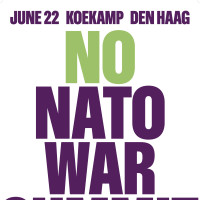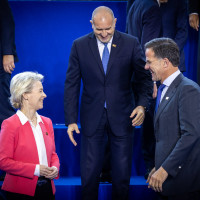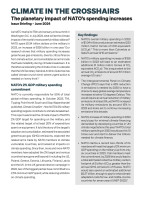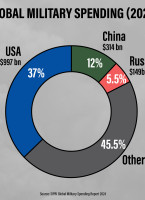NATO’S 3.5% Spending Goal Unsustainable on every count
Fecha de publicación:
17
minutos de lectura
In 2025, there is one glaring security challenge facing everyone in the world – and that is the climate crisis. Every scientist studying climate change is sounding an alarm that we are close to dangerous tipping points that threaten liveability on this planet for millions of people. We have faced two of the hottest years on record consecutively, unprecedented forest fires and extreme weather events are becoming ever more normal, and we will almost certainly breach the 1.5 degree Celsius increase in global temperatures from pre-industrial levels within the next five years. Yet in June, the world’s biggest ‘security’ alliance, NATO, will be meeting in The Hague not to tackle this crisis but to add yet more petroleum to the fire.
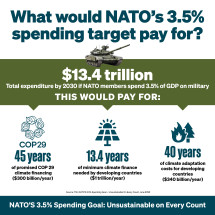
Descargas
NATO’S 3.5% Spending Goal: Unsustainable on every count
(PDF, 247.04 KB)
Tiempo medio de lectura: 17 minutos*
Key findings
- NATO’s 2% GDP spending commitment has already had major climate impacts with its hike in military spending and emissions. NATO military expenditure has surged by 25% from US$1177bn in 2021 to US$1506bn in 2024 while the corresponding estimated military carbon footprint has increased nearly 40% from 196 million metric tons of CO2 equivalent (MtCO2e) to 273 MtCO2e. In 2024, NATO’s European members plus Canada made the largest spending increase in decades (17.9%).
- NATO’s new 3.5% GDP spending goal would lead to a total military expenditure of US$13.4 trillion by 2030, a US$2.6 trillion increase above current expenditure. This can cover nearly three years worth of climate finance needs of developing countries at $1 trillion a year or pay outright for the world’s global electricity grid to be made Net Zero compatible by 2030.
- NATO’s new 3.5% spending goal would also lead to 2,330 MtCO2e of total carbon emissions by 2030, almost the same amount as the combined annual GHG emissions of Brazil and Japan; an additional 692 MtCO2e emitted above current levels. It would also cancel out the annual emission reduction of 134 MtCO2e needed to achieve the EU’s 2030 target of reducing GHG emissions by at least 55% compared with 1990 levels.
- Prioritisation of military expenditure is already weakening Europe’s climate and environmental goals. The Recovery and Resilience Facility (RRF), the largest source of EU grants for a green transition, is due to end in 2026. This will leave a major gap in EU funding of at least ! 180 billion for the 2024 to 2030 solely to meet existing inadequate levels of investment.
- NATO members have already failed over the last decade to deliver even limited promised climate finance to the poorest countries, spending 52 times as much on the military as they have on climate finance. This looks set to worsen. NATO member states have increased military investment by an average of 14.8% while reducing aid budgets by 7.3% between 2023 and 2024. With roughly a third of ODA spent on climate funding, there is a high risk that these decreases lead to less spending on climate change adaptation and mitigation. Escalations in military investment and further reductions in aid budgets in 2025 suggest even more broken promises.
- NATO’s 3.5% spending goal could escalate a dangerous arms race if it becomes the standard globally. If China also adopted the same goal, for example, it would immediately double China’s military expenditure to $646bn, with the consequent impacts on military emissions and possible diversion of climate and social investments to military ends.
- Arms companies are the big winners of the current wave of militarisation with the top ten largest arms companies in NATO countries revenues rising by an average of 7.79% between 2023 and 2024.
